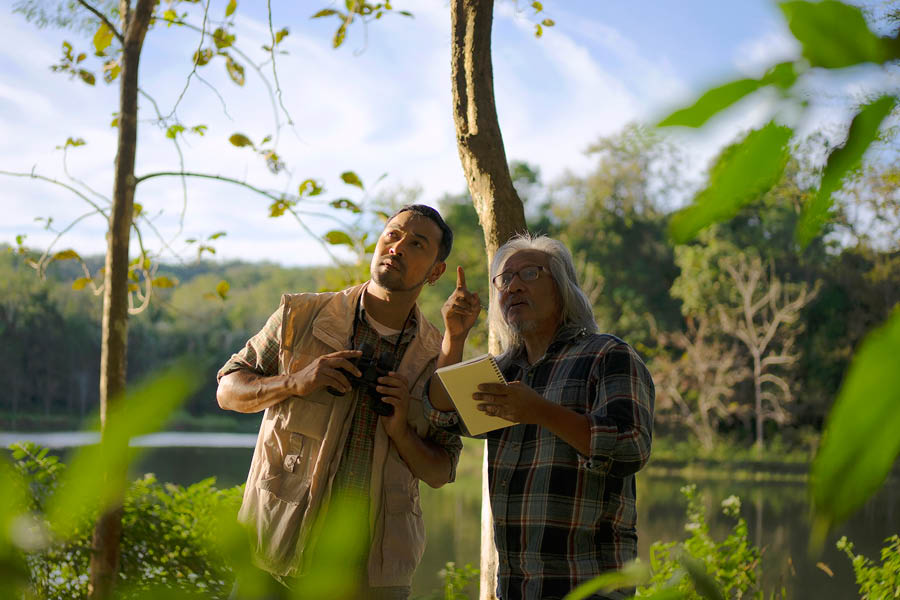The monsoon season in India isn't just about the pitter-patter of rain and the lush greenery — it’s also a birder’s dream! From the misty mountains of Arunachal Pradesh to the coastal swamps of Maharashtra, India teems with feathered friends during the rainy season. Whether you're a seasoned birdwatcher or simply looking for a unique outdoor adventure, India's monsoon birding havens are sure to delight you. So, grab your binoculars, pack your rain gear, and get ready to explore some of the best places to spot these winged wonders.
Ratnagiri — a monsoon birding paradise

A variety of kingfishers Pranav Joshi
Nestled along the Konkan coast of Maharashtra, Ratnagiri offers a unique blend of natural beauty and rich biodiversity, especially during the monsoon season. This region, renowned for its lush landscapes, cascading waterfalls and pristine beaches, is also a birder's paradise.
According to Pranav Joshi, a certified naturalist who curates special trips for birding enthusiasts in this region, rains are the ideal time to spot a wide range of birds. Birders can see more than 25 varieties of birds, including the Hooded oriole, Indian silverbill, Vigor’s sunbird, Weaver sunbird, Grey-breasted prinia and Orange minivet, amongst others. He adds, “What makes Ratnagiri special during monsoons is that you can see five varieties of kingfishers — Oriental dwarf, Blue-eared, Stork-billed, Small blue, and White-throated, and all in a 5-7km radius just outside the main city, which saves travel time.”
Cost: A three-day package with four birding sessions, naturalist charges, stay, and meals cost Rs. 17,500 per person
Best time to visit: June-end to September-end
Best way to reach: Drive from Pune airport (7 hours) and Mumbai airport (8 hours)
Bhigwan — a monsoon retreat for avian enthusiasts
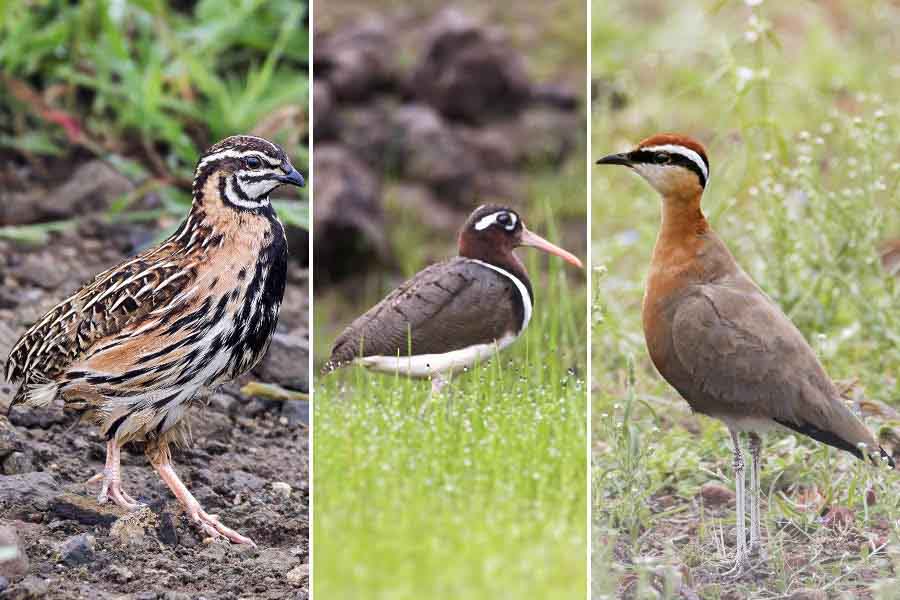
(L-R) Rain Quail, Painted Snipe and an Indian Courser Dhananjay Dravid
Bhigwan, a quaint village nestled in the Pune district of Maharashtra, transforms into a birding paradise during the monsoon. Abundant rainfall creates a vibrant ecosystem that attracts a diverse array of avian species. The wetlands, marshes, and rice paddies around Bhigwan provide ideal habitats for waterbirds, migratory birds and local residents. More than 50 species of birds can be spotted in their natural habitat here. Bar button quails, Painted francolin, Shorted snake eagle, Vernal hanging parrot, Crested bunting, a splendid variety of owls, Indian silverbill, Rufous-tailed lark, and Ashy-crowned sparrow lark are some of the common sightings here.
Arwind Waghmare, an experienced naturalist and birder, curates special trips during monsoons to see these feathered varieties. According to him, Bhigwan comes alive during the rains. Many waterbodies in the small town make for ideal habitats for birds. Besides birds, many mammals like hyenas, wolves, jackals and foxes are also sighted here, making Bhigwan an ideal choice for birders and animal-lovers during this season.
Cost: A full-day birding package with a guide is priced at Rs 8,000. For those interested in night trails to spot the nocturnal creatures like owls, Rs 1,000 additional. The room tariff is Rs 1,000, excluding food
Best time to visit: June-end to September-end
Best way to reach: Drive from Pune airport (1.5 hours), or Mumbai airport (4 hours)
Wayanad — a birder’s dreamland
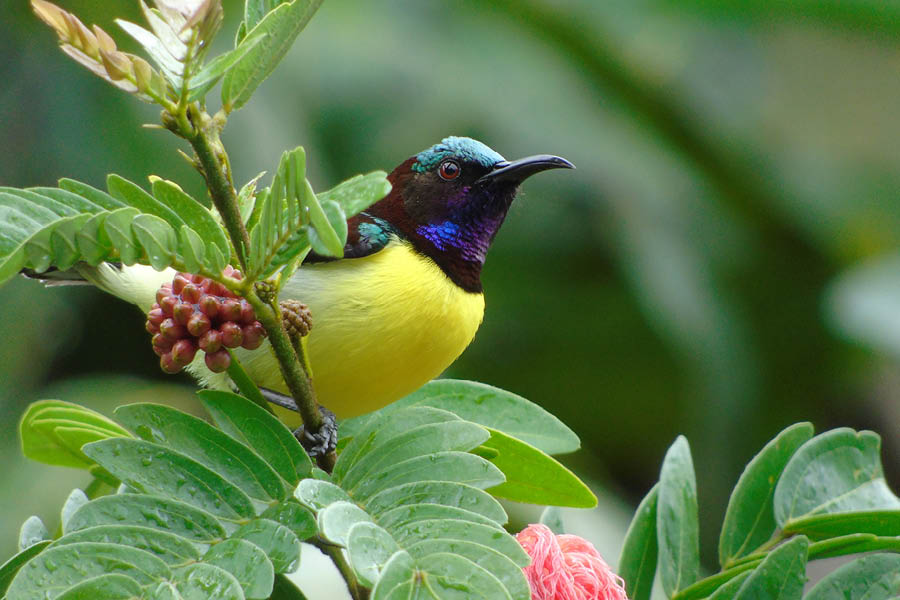
Purple rumped sunbird of Wayanad on a flowering plant Shutterstock
Rejuvenate in the mist-clad mountains of Wayanad, where the greenery during the monsoons adds to the perplexing beauty of the region. Set in this beautiful backdrop is Wayanad Wildlife Sanctuary, part of the Nilgiri Biosphere Reserve, a UNESCO World Heritage Site. The sanctuary is located in the southern trenches of the Western Ghats and is ranked 8th in the list of the world’s biodiversity hotspots. Bibin Baby, a renowned and experienced naturalist in Wayanad, says, “Wayanad is a beautiful place for birding in the monsoons due to its thick evergreen vegetation, attracting frugivore and carnivorous birds in equal numbers. Besides birds, you can also see varieties of cicadas, grasshoppers, dragonflies, whitewater fish, frogs, and tadpoles.”
The region boasts about 250 species of birds. Some of the commonly sighted birds here are Asian fairy bluebirds, Asian paradise flycatchers, Orange-headed thrush, Malabar parakeets, Malabar whistling thrush, Emerald doves, Scarlet minivets, and many more. It also has a variety of birds of prey, including the Amur falcon, Crested serpent eagle, long-tailed shrike, and many others. In Wayanad, you have a unique distinction of spotting wetland birds, too, such as the Woolly-necked stork, Pheasant-tailed jacana, Common Coot, and Darter, amongst others.
Talking Trees, a homestay located on the banks of the Kabini River near Kuruva Island is one of the most preferred places for birders to stay in Wayanad, with 50-60 bird species of birds found in and around the property. Bibin conducts birdwatching walks along Kabini River till Kotillam, a naturally formed mud pit in Kabini River, which is a haven for wetland birds. Charges for one birdwatching trek is Rs 3,000 for a group of 1- 5 people.
Cost: Room tariff starts from Rs 5,000+taxes for double occupancy, including breakfast
Best time to visit: June to September end
Best way to reach: Calicut and Mysore Airport (3 hours)
Eaglenest Wildlife Sanctuary — a treasure trove of birds
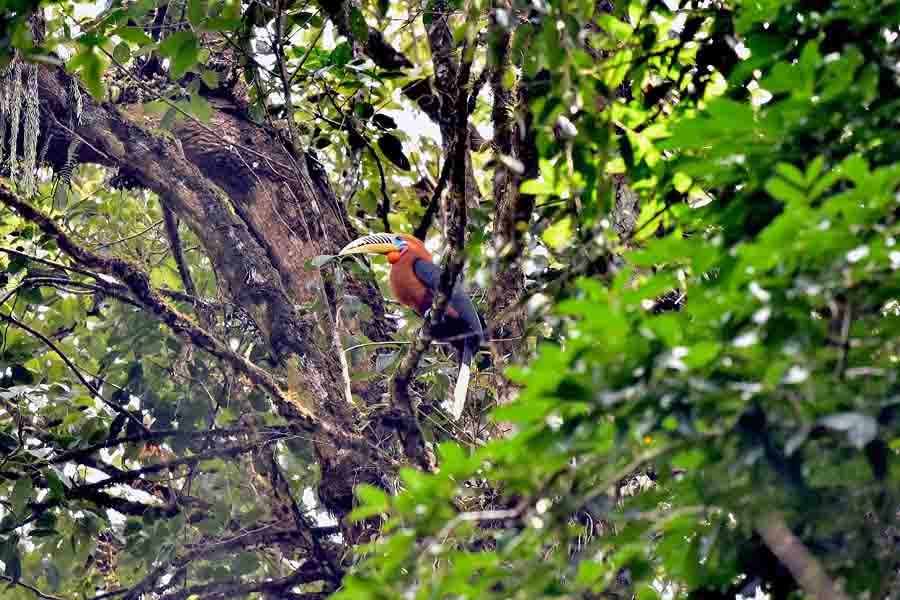
A rufous-necked hornbill at the Eaglenest Wildlife Sanctuary Shutterstock
Located in the west Kameng district in Arunachal Pradesh, Eaglenest Wildlife Sanctuary is one of the most sought-after birding destinations in the world. The checklist of birds has been increasing faster than the expectations of the birding community. The sanctuary offers a unique blend of temperate forests, alpine meadows and river valleys, attracting a diverse array of avian species.
From the majestic eagles soaring high above to the colourful warblers flitting through the undergrowth, Eaglenest offers an unforgettable experience for nature enthusiasts and bird watchers alike. What makes Eaglenest special is that even during torrential monsoon rains, when most of Arunachal Pradesh is cut off, Eaglenest is open, offering tourists unparalleled access to the flora and fauna of the region.
While here, you are sure to spot Brown-throated fulvetta Gold-naped finch, Yellow-breasted greenfinch, Maroon-backed accentor, and Himalayan cutia. Chestnut-crowned laughing thrush and Yellow-bellied fantail, Bugun liocichla, Brownish-flanked bush warbler, Spotted Alachua, and Scaly-breasted cupwing are some other beautiful birds seen here. Besides birds, the sanctuary has more than 60 species of butterflies and mammal species like the Gaur, Orange-bellied Himalayan Squirrel, Red Panda, Arunachal Macaque, and endangered capped Langur, Bengal Tiger, and Clouded leopard — making it a rounded experience.
Bompu Camp and Lama Camp are some of the best places to stay near Eaglenest. They offer basic but comfortable accommodation.
Cost: Room tariff is Rs 2,500-2,800 per person, including meals. Guide charges amount to Rs 2,500 per day
Best time to visit: May to October
Best way to reach: Guwahati Airport (8-9 hours) or Tezpur (about 4 hours)
Dihing Patkai National Park — the perfect canopy for winged beauties
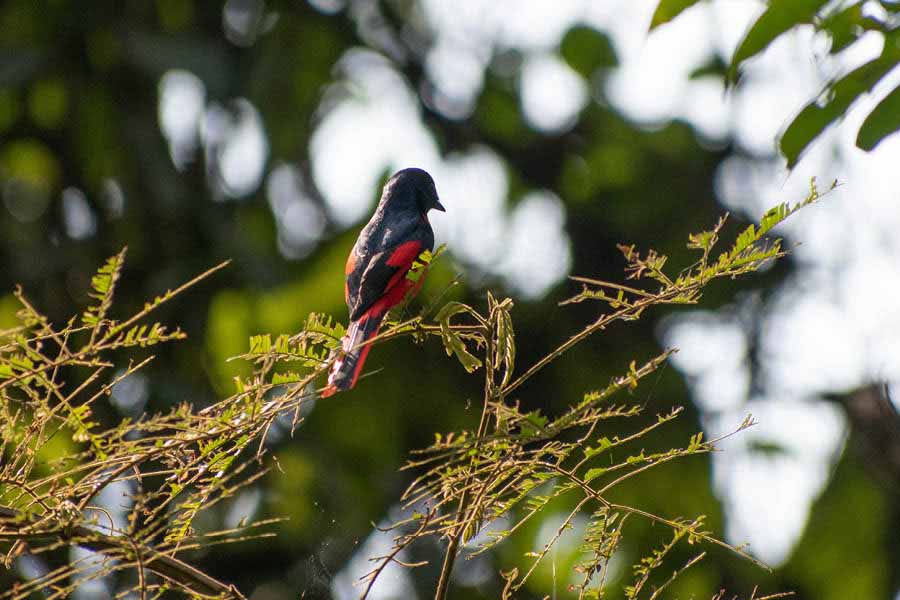
A Scarlet Minivet in Dihing Patkai National Park Shutterstock
Nestled in the foothills of the Eastern Himalayas in Assam, Dihing Patkai National Park is a multi-layered rainforest with a tall canopy of trees and a dense layer of ferns and bushes, making it the perfect abode for a wide range of birds.
Laughing thrushes and bablers make the undergrowth their home, while raptors like Red-headed trogon, Oriental honey buzzard, and Greater necklaced laughingthrush soar high in the sky. Other unique birds here include, Pale-capped pigeon, Ruby-cheeked sunbird, Violet cuckoo, Wreathed hornbill and Grey peacock pheasant, amongst others.
Unlike other birding destinations, at Dihing Patkai, you can indulge in nocturnal birding, too, witnessing the wonder of owls. Spot-bellied eagle owl and Oriental bay owl, two of the rarely photographed birds in India, make their haunting presence here. You can navigate this beautiful forest on foot, by vehicle, and also by elephants, making it a thrilling experience.
Due to its remote location, there are no big hotels near the park, but the forest guesthouses make for ideal stay options as they are located within 2km of Dihing Patkai National Park. They offer comfortable and affordable accommodation. It is advisable to book them in advance by emailing the District Forest Officer in Dibrugarh.
Cost: Room tariff available from the District Forest Officer in Dibrugarh
Best time to visit: November to mid-May (though Monsoons offer a unique set of avian birds)
Best way to reach: Dibrugarh Airport (1.5 hours)
